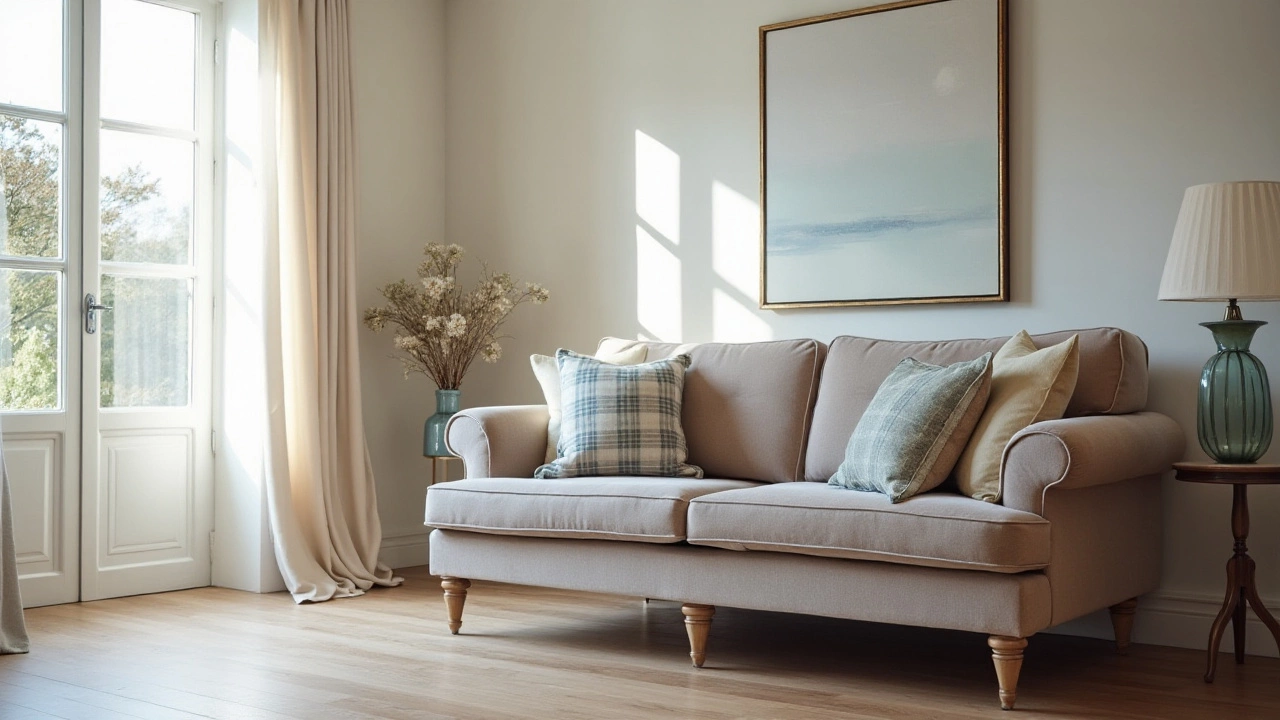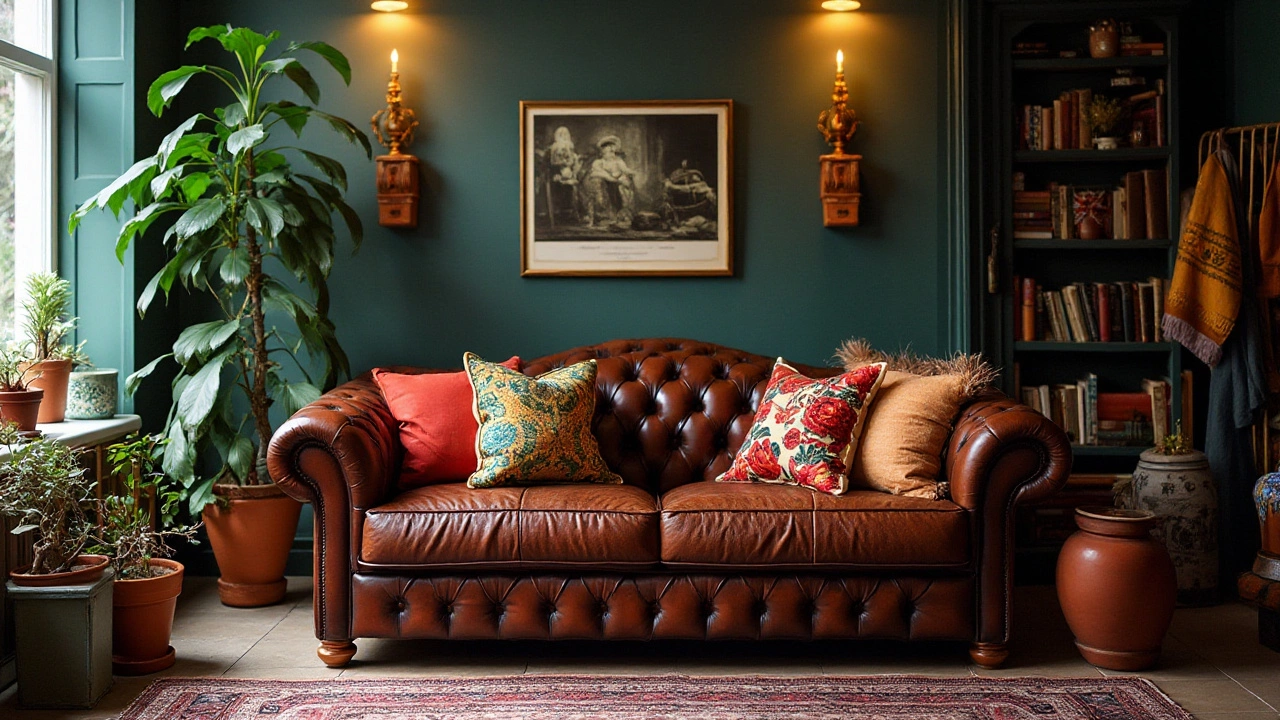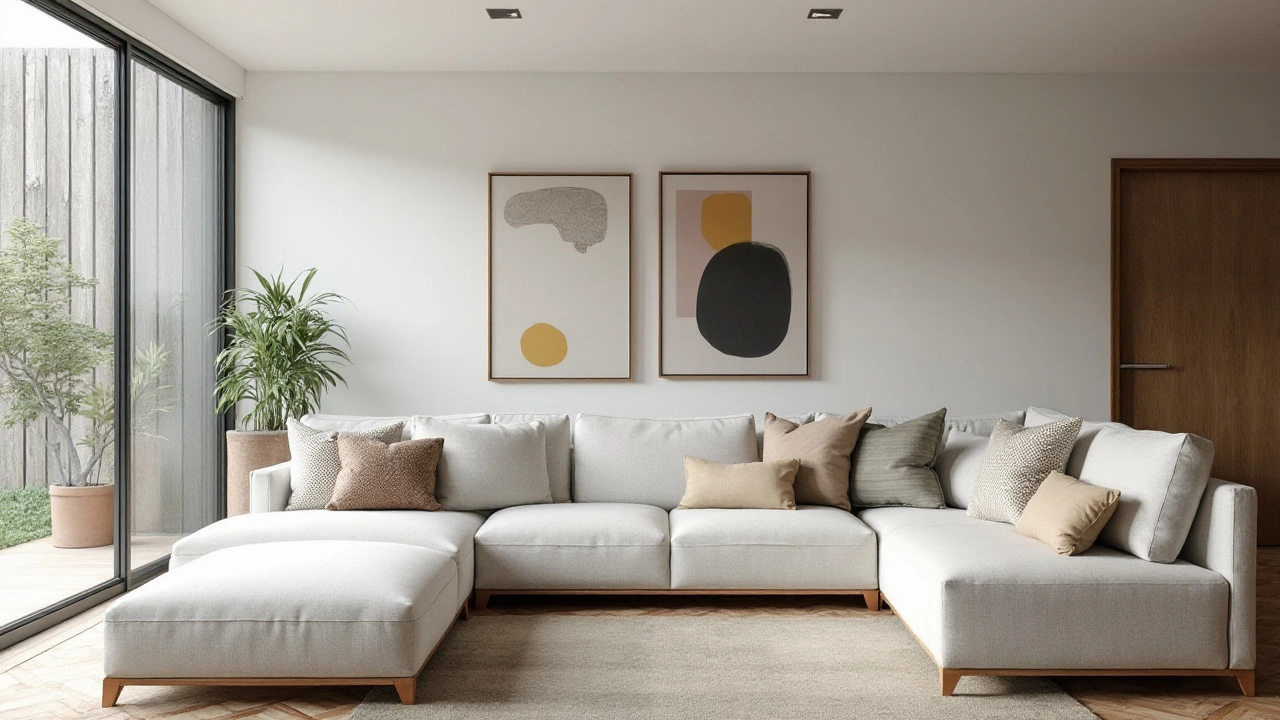The Perfect Number of Cushions for a Stylish Sofa
 Jan, 26 2025
Jan, 26 2025
There's a certain charm and allure that cushions bring to a sofa, transforming it into a focal piece of your living room. But, how many cushions should really grace your couch? The answer isn't as straightforward as it might seem and varies from one style preference to another.
A key consideration is balancing aesthetics with comfort, ensuring that you’re not simply burdening your space but enhancing it. Whether you're a fan of elegance or coziness, the right number of cushions can set the desired tone. In the following sections, we'll explore how to strike the perfect balance and breathe life into your living room.
- The Science of Cushion Numbers
- Balancing Style and Comfort
- Choosing the Right Sizes and Shapes
- Mixing Patterns and Colors
- Personalizing Your Space
The Science of Cushion Numbers
The art and science behind how many sofa cushions one should have is often underestimated. It’s more than just a numbers game; it's about finding the right formula that aligns with the size of your sofa, the style of your home, and the comfort you aim to achieve. Traditionally, interior designers recommend starting with an odd number of cushions—like three or five—as they say this creates a more aesthetically pleasing arrangement, breaking symmetry and adding a touch of creativity to the room’s aesthetic. However, with evolving fashion and design trends, even this 'rule' becomes flexible.
One key aspect to keep in mind is the size of your sofa. For smaller sofas, two or three cushions might be sufficient, avoiding a cluttered look. On larger couches, five to seven cushions can appear inviting and offer ample opportunity for layering textures and mixing patterns. Some might argue that comfort can be compromised by too many cushions, citing that people often find themselves needing an extra seat only to relocate cushions elsewhere. According to the design expert Sarah Gibson, "It’s not just about filling the space with items, but enhancing the seating experience while adding a touch of elegance."
"Whoever said less is more was never talking about cushions," she notes, highlighting the delicate balance between style and practicality.
Style preferences play a leading role too. If you appreciate a modern minimalist look, fewer cushions might suit your space better. This lets the sleek design of the living room furniture shine and ensures practicality. Yet, if you’re designing for comfort and coziness, layering multiple cushions is ideal, each offering its own unique texture to touch and vibrant color that draws the eye in. The key is to keep arrangement in mind; a scatterback approach might suit some, while others prefer cushions aligned methodically in a structured fashion.
Interestingly, a survey conducted by HomeGoods found that 60% of participants rearranged their cushions weekly, illustrating how dynamic cushion styling could be. Most people explore different configurations, utilizing their cushions as a tool for visual storytelling across seasons. A simple change of decor tips, like rotating cushion covers or interchanging textures from spring to fall, can offer a refreshing look without opting for entirely new furnishings. Doubling up different textures and colors also provide layers of interest and add warmth to an otherwise streamlined setting.
In conclusion, there’s no universal answer to the magic number when it comes to cushions. Experimentation can often lead to impressive results, allowing you to reflect your personal style while keeping comfort at its core. Prioritizing how you wish to interact with your space and the feelings you desire it to evoke will guide you in making the best choice.
Balancing Style and Comfort
When it comes to finding the sweet spot between style and comfort in cushion arrangements, it often starts with understanding the unique role of sofa cushions in your living room. Too many, and you'll find yourself constantly adjusting them—fighting with a sea of fabric rather than lounging in bliss. Too few, and your space may feel barren, lacking warmth and inviting allure. The first rule in achieving balance is considering the size and shape of your sofa. A sprawling sectional can accommodate more cushions, often needing them for practical support, while a compact loveseat might call for only a pair. This isn’t merely a rule of thumb; it’s about achieving harmony between form and function, which is precisely what allows your room to feel both stylish and lived-in.
Speaking of harmony, choosing the right combinations can significantly amplify a room's aesthetics. Let's look at colors and textures next. Employing an ideal mix of these elements can elevate the overall feel of your space, inviting guests to linger a bit longer. Experts often say mixing textures—like pairing soft velvet with durable canvas—can add an element of interest while also serving varying needs, from plush coziness to firm support. According to an article I read in Home Beautiful, "The secret to a perfect couch isn't just found in dimensions or designs, it's in those unnoticed touches." This rings true, doesn’t it? Those ‘touches’ are what make the difference between a room that feels cultivated and one that feels cluttered.
Moreover, your cushion arrangement should serve to reflect personal style. While symmetry lovers might opt for arranging cushions in even numbers, those who like to embrace their eclectic side might choose odd numbers—shifting focus to asymmetry which often feels more organic and inviting. The Japanese principle of wabi-sabi embraces imperfection, and applying this to cushion arrangements can result in a less rigid, more natural look. This aesthetic approach can make spaces feel effortlessly comfortable without appearing staged.
In the art of blending style and comfort, it's worth considering any particular needs you might have. For instance, opting for varied cushion fillers can contribute to both visual and physical comfort. Feather-filled cushions, known for their fluffiness, can nicely juxtapose firmer foam-filled options which offer enduring support. This variety not only provides tactile diversity but also caters to different sitting experiences. Keep in mind how this aligns with your living habits, from movie nights to social gatherings.
It’s interesting to note that in a survey conducted by the Home Furnishing Journal, an overwhelming majority of respondents expressed that cushion arrangement heavily influences their perception of comfort at home. While not a straightforward statistic, it certainly underscores the importance of consideration in these aspects. Allow your room to tell its own story through decor tips, every cushion a chapter in a novel woven from threads of style and solace.
Ultimately, there exists no one-size-fits-all approach. The key lies in listening to what your space—and your comfort—crave the most. Let experimentation guide your choices; move those sofa cushions around, and see where they naturally fall into place. It's not merely about decorating; it's about creating an environment that brings joy to your everyday moments while resonating with your personal style. So go ahead, strike a balance that's uniquely yours.

Choosing the Right Sizes and Shapes
When it comes to selecting sofa cushions, size and shape are pivotal in creating an inviting and stylish setting. The dimensions of your cushions should not only align with your sofa size but also complement the overall decor of your living room. A common approach is to blend varying sizes to establish an appealing balance and contrast. For example, pairing larger square cushions with smaller round ones can add both depth and diversity to the visual experience. This allows for a mix-and-match setting that sparks interest without overwhelming the eye.
The shape of the cushions is just as crucial as the size. The conventional square cushion offers versatility, lending itself to any decor theme, while elongated rectangular cushions, often referred to as lumbar pillows, provide excellent support and a modern touch. Circular cushions bring a playful element and can act as attention-grabbers when used sparingly amidst a sea of squares. According to interior designers, a varied mix of shapes and sizes infuses a dynamic energy into the setting. "A good rule of thumb is to include one or two standout designs," says Emily Henderson, a noted stylist, "They not only add visual interest but also reflect personal style preferences."
An often overlooked aspect is the proportion of the cushions relative to the sofa. A compact loveseat doesn't suit huge, bulky cushions that can make it appear overstuffed. Instead, medium-sized cushions can provide a cozy, inviting look. Conversely, a spacious sectional might call for oversized cushions to match the scale without feeling sparse. Each cushion should contribute to a harmonious, cohesive look that caters to both aesthetic appeal and comfort for anyone lounging around.
Experimentation with different sizes and shapes of cushions can also serve a dual purpose, by not only enhancing the decor but offering functional benefits as well. People generally appreciate the option of selecting a cushion that provides neck support when they lean back, or a bolster for additional lumbar support. Considering these factors can elevate the practical utility of cushions beyond mere ornamentation. Among the abundant options available, remember that each decision should resonate with you and reflect your unique style, while ensured functionality is never sacrificed.
Keeping up to date with contemporary trends can also provide insight into which cushion sizes and shapes are in vogue. For instance, current trends often embrace minimalist concepts with fewer, larger cushions that make a bold statement. Nonetheless, balance personal taste with these trends to avoid creating a space that feels inauthentic or overly styled. Striking the right balance is a personal journey, one filled with creativity, and a sense of satisfaction in transforming your living space into an oasis of both beauty and comfort.
Mixing Patterns and Colors
Diving into the colorful world of cushions means playing with a palette before your eyes. The art of mixing patterns and colors can make your sofa a trendy masterpiece, or it can be a visual mess if not done thoughtfully. It’s heartening to know that there are a few tried and true principles that can guide even the most novice decorator into crafting a space that exudes charm and character. Picture a lively tapestry that triggers curiosity, each cushion telling its own story through bold hues and intricate designs.
Start with a color scheme that resonates with your personal style. A simple trick is selecting three colors as your base—often a neutral one, a bold hue, and a contrasting shade. These serve as a guideline to ensure the cushions complement rather than clash with the existing elements in your living room. Within those colors, play with shades and tones to create depth and interest. Choosing cushions that share a similar palette but differing patterns can beautifully balance the composition.
"Combining colors and patterns should be like conducting an orchestra, each cushion is an instrument, playing in harmony to create an ambient symphony of design and comfort." —Interior Design Magazine
As you step further into patterns, an exciting array awaits. Start with one large scale pattern as the anchor, which could be a geometric print or a bold floral design. The trick here is contrast. Smaller repetitive patterns, such as polka dots or pinstripes, work wonderfully around the anchor piece, providing both harmony and variety without overwhelming the space.
Cushion arrangement often thrives with an odd number; consider using five to seven cushions to offer a deliberate disarray. Each arrangement should tell its own story, creating a dynamic dialogue on your sofa. It might seem like magic, but it's simply an orchestra of patterns coming together. Don’t shy away from experimenting, for sometimes the most unexpected combinations can lead to breathtaking results.
If you're willing, add textures to the mix, as they are the unsung heroes in the decoration process. Fabrics such as velvet, linen, or silk weave their own kind of magic, adding layers to your decor. Allowing oneself to mix patterns alongside these luxurious textures can be a bold step towards redefining your room’s personality. Remember, living room style reflects who you are, so there's no wrong combination as long as it brings joy to your space.

Personalizing Your Space
Your living room should be a reflection of your personality, a cozy sanctuary that speaks volumes about who you are. One of the simplest yet effective methods to personalize this space is by creatively arranging your sofa cushions. The choice of color, texture, and pattern can dramatically transform the look and feel of your entire room. A thoughtfully curated mix of cushion styles not only makes your sofa more inviting but also adds depth and character to your living area. Start by considering the mood you want to evoke: is it warm and welcoming, or sleek and modern? Your choice should align with the overarching theme of your home decor while retaining a touch of personality.
When it comes to choosing styles, there's a world of options available. Consider incorporating your favorite patterns or choosing colors that you are naturally drawn to. If you love a particular shade, work it into your cushion array. Custom designs with personal messages or images can add a unique touch. Playing around with different shapes like rectangular, square, or even circular cushions can offer a multi-dimensional look, further enhancing the style quotient. As you explore options, remember that the goal is not to clutter but to complement your existing furniture.
For an additional layer of sophistication, the concept of seasonality can be introduced to your cushion arrangement. As seasons transition from spring to summer and beyond, your cushions can keep pace, reflecting changes in color palettes, materials, and styling preferences. In spring, think florals and pastel shades; while in winter, consider deep hues and cozy, knitted textures. This dynamic approach keeps the living room fresh and in tune with nature's cycles. As renowned interior designer Nate Berkus once said,
"Your home should tell the story of who you are and be a collection of what you love."
Purposeful personalization often leads to a more meaningful connection with your home. Consider adding thematic elements that align with personal interests or life stories. If travel is your passion, cushions featuring patterns inspired by different cultures could echo your adventurous spirit. Alternatively, cushions with printed quotes or inspiring words might appeal to the philosopher within. The significance of these elements lies not just in aesthetics, but also in the emotional connection you develop with the space around you.
Accentuating the space with accessories harmonized with these decor tips can enhance stability and unity in design. A well-thought-out color scheme for your cushions can blend seamlessly with other living room components such as curtains, rugs, or throws, which then work together to create a cohesive look. Moreover, the visual impact can be amplified by arranging cushions symmetrically or asymmetrically, depending on the desired balance. A simple arrangement might involve two larger cushions on either end of the sofa, with a contrasting smaller cushion in the middle, creating a pleasant symmetry.
For those who love to experiment, a touch of boldness can go a long way. Don't shy away from unexpected combinations—pair a vintage cushion with a contemporary design for an eclectic vibe. The living room is a dynamic space, and your cushion arrangement should echo its vibrancy and life, providing not just comfort but also an avenue for expression. Ultimately, the way you personalize this space with cushion arrangements speaks to your creativity, transmitting warmth and charm to everyone who enters your home.